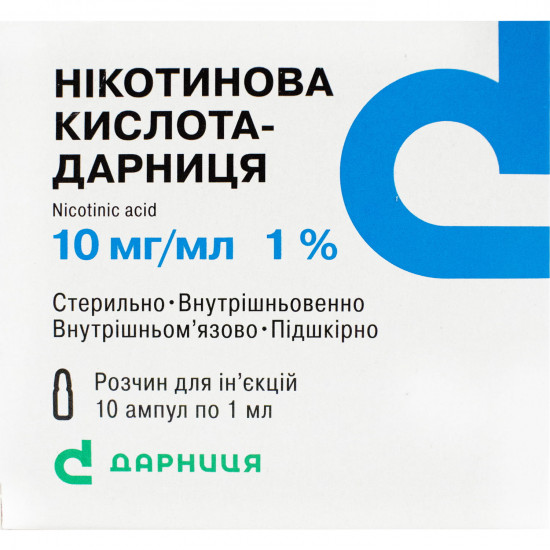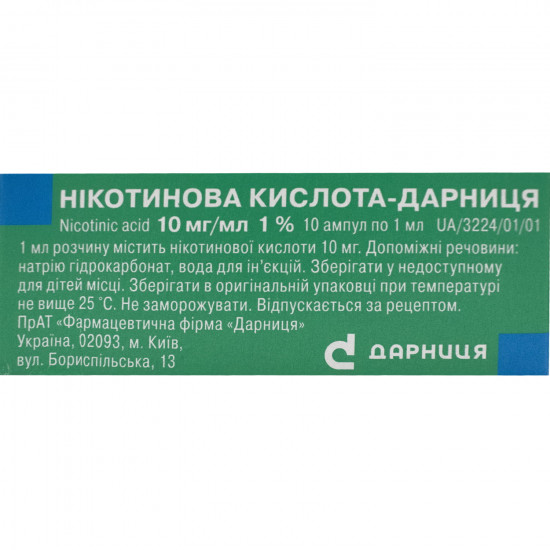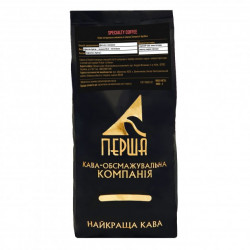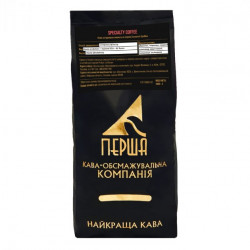



- Stock: In Stock
- Model: 179205
0% Customers recommend this product
-
5 Awesome0%
-
4 Great0%
-
3 Average0%
-
2 Bad0%
-
1 Poor0%
Reviews Over Nicotinic k-ta-Darnitsa solution for infection. 10mg/ml amp. 1 ml No. 10
- (0)
Total Reviews (0)
click here write review to add review for this product.
Report this review.
Description
Pharmacological properties
Pharmacodynamics. niacin (vitamin rr) independently or in the form of amide is prosthetic group of enzymes — co-dehydrases i (a diphosphopyridine nucleotide — over) and the ii co-dehydrases (a trifosfopiridinnukleotida — nadf) which are carrying out transfer of hydrogen in redoxreactions and also phosphate transfer.
Participating in a metabolism, tissue respiration, synthesis processes, niacin normalizes the maintenance of lipoproteids and triglycerides in blood.
Has vasodilating impact at the level prearteriol and arterioles (including a brain) owing to what microcirculation improves.
Has weak anticoagulating effect (increases fibrinolytic activity of blood), has disintoxication properties thanks to strengthening of disintoxication function of a liver and kidneys.
is Eliminated by deficiency of RR vitamin, is specific antipellagric means.
Pharmacokinetics. Niacin is quickly soaked up from the injection site at parenteral application. It is evenly distributed on all bodies and fabrics. It is inactivated mainly by methylation and to a lesser extent — by conjugation. Products of biotransformation are excreted with urine. Niacin can be defined in urine in an active form if the increased its quantity comes to an organism.
Indication
Treatment of a pellagra (pp vitamin avitaminosis). ischemic violations of cerebral circulation. angiospasm of extremities (obliterating endarteritis, Raynaud's disease). angiospasm of kidneys. wounds, ulcers which a long time do not heal. diabetes complications (diabetic polyneuropathy, mikroangiopatiya). gipoatsidny gastritis, coloenteritis, colitis. liver diseases (acute and chronic hepatitises). neuritis of a facial nerve. intoxications of various genesis: professional, alcoholic, medicamentous (aniline derivatives, barbiturates, antituberculous remedies, streptocides).
Use to Appointby
to adults and children 15 years in/in (slowly), in oil and p / are aged more senior to (in oil and p / to an injection are painful).
For in/in jet of introduction a single dose of medicine to dissolve within 10 ml 0.9% of solution of sodium of chloride and to enter not less than in 5 min. (no more than 2 mg of niacin in 1 min.).
For in/in drop of introduction a single dose of medicine to dissolve within 100–200 ml 0.9% of solution of sodium of chloride, rate of administering — 30–40 drops a minute.
Pellagra. To appoint in/in or 1–2 times, in oil on 10 mg (1 ml), a day. A course of treatment — 10–15 days.
Ischemic violations of cerebral circulation. In/in (slowly) to enter 10 mg (1 ml).
Other indications. To appoint p / to or in oil 10 mg (1 ml) of 1 times a day within 10–15 days. Addition in infusional solution of 10 mg (1 ml) of niacin on 100–200 ml of solution is possible.
Highest doses at in in introduction: single — 100 mg (10 ml), daily — 300 mg (30 ml).
Contraindication
Hypersensitivity to medicine components. a peptic ulcer of a stomach and duodenum (in an aggravation stage), gout, a hyperuricemia, a heavy liver failure (including cirrhosis), severe forms ag and atherosclerosis (in/in introduction), dekompensirovanny diabetes, a recent myocardial infarction, sudden decrease in peripheric vascular resistance in the anamnesis.
Side effects
from a cardiovascular system: inflows which can be followed by an asthma, tachycardia, the heartbeat increased by sweating, a fever, hypostases, feeling of pricking and burning; arrhythmia; at fast in in introduction — considerable decrease hell, orthostatic hypotension, collapse.
from the central and peripheral nervous system: dizziness, paresthesias, headache.
from the immune system, leather and hypodermic cellulose: a dermahemia of the person and the top half of a trunk with feeling of pricking and burning, dryness of skin and mucous membrane of eyes, it is rare — hypostasis of a retina of eyes, is very rare at patients with an ischemic heart disease — an acanthosis. These symptoms are unstable and disappear after medicament withdrawal. Reactions of hypersensitivity, including from respiratory organs, urticaria, an itch, rash.
Local reactions: morbidity, a swelling in the place p / to and injections in oil.
At prolonged use in high doses — a hyperuricemia, decrease in tolerance to glucose, an abnormal liver function, fat dystrophy of a liver, jaundice, increase in the AsAT, LDG, SF level, uric acid, a hypophosphatemia, decrease in quantity of platelets, increase in a prothrombin time, a hyperpegmentation, a hyperkeratosis, spasms, diarrhea, nausea, vomiting, anorexia, exacerbation of stomach ulcer, an amblyopia, insomnia, myalgia, decrease in the ABP, rhinitis, misting of sight, the century, a myopathy, exfoliative dermatitis swelled.
Special instructionsAs prolonged use can lead
to fat dystrophy of a liver, for prevention of the last it is necessary to include products rich with methionine in a diet of patients or to appoint methionine, lipoic acid. in the course of treatment it is necessary to control function of a liver. at emergence of hypersensitivity to medicament (except for application cases as vasodilator) it can be replaced with niacinamide. to apply
With care at hyperacid gastritis, a peptic ulcer of a stomach and duodenum (out of an aggravation stage), hemorrhages, glaucoma, a renal failure, arterial hypotension of moderate degree, an alcohol abuse, unstable stenocardia (the patients accepting nitrates, antagonists of calcium channels, blockers of β-adrenoceptors).
Use of medicine can leadto increase in need for insulin at patients with diabetes. It is inexpedient to apply to correction of a dislipidemiya at patients with diabetes.
needs to carry out byregularly monitoring of level of glucose in connection with possible decrease in tolerance to glucose and also the level of uric acid in blood plasma because of possible increase as a result of long therapy.
Use during pregnancy and feeding by a breast. Drug is contraindicated during pregnancy. In need of use of medicine it is necessary to stop feeding by a breast.
Children. Drug to children to appoint aged more senior than 15 years.
Ability to influence speed of response at control of vehicles or other mechanisms. Researches about influence of medicine on speed of response were not conducted, however if during treatment the dizziness and drowsiness are observed, it is necessary to abstain from work with mechanisms.
Interaction
Oral contraceptives and an isoniazid reduce transformation of tryptophane into niacin and thus can increase the need for niacin.
Niacin reduces efficiency and toxicity of a probenetsid, Neomycinum, barbiturates, antituberculous remedies, streptocides.
Antibiotics can strengthen the erubescence caused by niacin.
Acetylsalicylic acid reduces the effect of erubescence arising under the influence of niacin.
Tsiprofibrat is not recommended to combinewith niacin.
Lovastatin, pravastatin because of increase in risk of development of side reactions is not recommended to combine with niacin. There are messages about rhabdomyolysis cases at use of niacin with lovastatiny.
needs to be careful at a combination with antihypertensives (possibly strengthening of hypotensive action), anticoagulants, acetylsalicylic acid (because of risk of development of a hemorrhage).
Drug exponentiates action of fibrinolytic means, spasmolysants and cardiac glycosides, toxic effect of alcohol on a liver.
Incompatibility. It is not necessary to mix with Thiamini chloridum solutions (there is a thiamine destruction), a pyridoxine of a hydrochloride, cyanocobalamine, Euphyllinum, salicylates, tetracycline, sympathomimetics, a hydrocortisone.
Overdose
Symptoms: strengthening of side effects from a cardiovascular system — arterial hypotension, a headache, is possible a loss of consciousness, dizziness, feeling of inflow.
Treatment: medicament withdrawal, disintoxication therapy, symptomatic treatment. Specific antidote is absent.
Storage conditions
In original packing at a temperature not above 25 °C. not to freeze.
Specifications
| Characteristics | |
| Active ingredients | Niacin |
| Amount of active ingredient | 10 mg/ml |
| Applicant | Darnitsa |
| Code of automatic telephone exchange | C04AC01 niacin |
| Interaction with food | It doesn't matter |
| Light sensitivity | Not sensitive |
| Market status | Traditional |
| Origin | Chemical |
| Prescription status | According to the prescription |
| Primary packing | ampoule |
| Producer | DARNITSA CIAO PHARMACEUTICAL. FIRM |
| Quantity in packing | 10 ampoules on 1 ml |
| Release form | solution for injections |
| Route of administration | Intramuscular |
| Sign | Domestic |
| Storage temperature | from 5 °C to 25 °C |
| Trade name | Niacin |




















